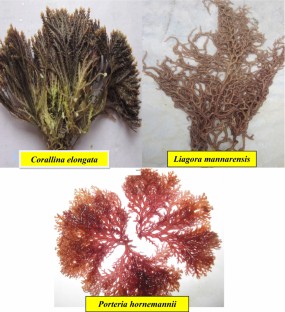Characterisation of carrageenan extracted from fresh and defatted red algae along the Pamban coast, Tamilnadu, India
Chidambaram Poonam, Jeyprakash Archanadevi, Chinnathambi Pothiraj
Research Articles | Published: 06 August, 2019
First Page: 281
Last Page: 287
Views: 3712
Keywords: Red algae, Carrageenan, Kappa, Lamda, Iota
Abstract
Studies carried out to breakdown the yield and Fourier-Transform Infrared (FTIR) spectral properties of polysaccharide from Corallina elongata (J.Ellis & Solander), Liagora mannarensis (V.Krishnamurthy & Sundararajan) and Portieria hornemannii (Lyngbye). Carrageenan yield in the range of 16.4 to 24.2% in fresh algae than 14.2 to 23.8% defatted algae was recorded. Spent biomass in the range of 62.0 to 72.0% in fresh algae than 61.2–70.4% defatted algae was recorded. Total sugar, reducing sugar and sulphate were maximum in P. hornemannii (Lyngbye) and minimum in C. elongata (J.Ellis & Solander) having fresh algae carrageenan compared to the defatted algae carrageenan. FTIR spectroscopy study shows that the carrageenan extracted from fresh and defatted C. elongata (J.Ellis & Solander) have both kappa and iota type carrageenan. Fresh and defatted carrageenan from L. mannarensis (V.Krishnamurthy & Sundararajan) and P. hornemannii (Lyngbye) have kappa, lamda and iota type carrageenan.

References
- Chopin T, Whalen E (1993) A new and rapid method for carrageenan identification by Ftir diffuse-reflectance spectroscopy directly on dried ground algal material. Carbohydr Res 246:51–59
- Chopin T, Hanisak MD, Kohen FE, Million J, Moreau S (1990) Studies on carrageenan and effects of seawater phosphorus concentration on carrageenan content and growth of Agardhiella subulata (C.Agardh) Kraft and Wynne (Rhodophyceae, Solieriaceae). J ApplPhycol 2:3–16
- Correa-Dı´az F, Aguilar-Rosas R, Aguilar-Rosas LE (1990) Infrared analysis of eleven carrageenophytes from Baja California Mexico. Hydrobiologia 204(205):609–614
- Craigie JS (1990) Cell walls. In: Cole KM, Sheath RG (eds) Biology of the red algae. Cambridge University Press, Cambridge, pp 221–258
- Craigie JS, Leigh C (1978) Carrageenan and agar. In: Hellebust JA, Craigie JA (eds) Handbook of physiological methods: physiological and biochemical methods. Cambridge University Press, Cambridge, pp 109–131
- Dubois M, Gilles KA, Gilles JK, Hamilton PA, Rebers F, Smith (1956) Colorimetric method for determination of sugars and related, substances. Anal Chem 28:350–356
- Estevez J, Ciancia M, Cerezo A (2004) The system of galactans of the red seaweed, Kappaphycus alvarezii, with emphasis on its minor constituents. Carbohydr Res 339:2575–2592
- Freile-Pelegrin Y, Robledo D (2006) Carrageenan of Eucheuma isiforme (Solieriaceae, Rhodophyta) from Yucatán, Mexico. II. Seasonal variations in carrageenan and biochemical characteristics. Bot Mar 49:72–78
- Imeson AP (2000) Carrageenan. In: Phillips GO, Williams PA (eds) Handbook of hydrocolloids, CRC Press, Boca Raton
- Krishnapillai V (1957) Chemical studies on Indian seaweeds. Proc Indian Acad Sci 3:1–22
- Lewis JG, Stanley NF, Guist GG (1988) Commercial production and application of algal hydrocolloides. In: Lembi CA, Robertwalland J (eds) Algae and human affairs. Cambridge University Press, Cambridge, pp 205–236
- Nelson WR, Van Staden J (1984) The effect of seaweed concentrates on the growth of nutrient-stressed, greenhouse cucumbers. J Horti Sci 19:81–82
- Palanivelu A, Padmanaban R, Sivakumar SR, Arunkumar K (2008) Yield and quality of agar and carrageenan from some red seaweed on varied substrata along Thondi coast (Palk Bay) Tamil Nadu. Seaweed Res Util 30(1&2):109–118
- Pelegrin P (2011) Many ways to dilate the P2X7 receptor pore. Br J Pharmacol 163:908–911
- Pereira L, Mesquita JF (2003) Carrageenophytes of occidental Portuguese coast: 1-spectroscopic analysis in eight carrageenophytes from Buarcos bay. Biomol Eng 20(4–6):217–222
- Pereira L, Sousa A, Coelho H, Amado AM, Ribeiro-Claro PJA (2003) Use of FTIR, FT-Raman and 13C-NMR spectroscopy for identification of some seaweed phycocolloids. Biomol Eng 20(4–6):223–228
- Rajasulochana N, Baluswami M, Vijayaparthasarathy MD, Krishnamurthy V (2008) FT-IR spectroscopic investigations on the agars from Centroceras clarulatum and Spyridia hypnoides. Int J Phycol Phycochem 4(2):125–130
- Rees DA (1969) Structure, conformation and mechanism in the formation of polysaccharide gels and networks. Adv Carbohydr Chem Biochem 24:267–332
- Roberts MA, Quemener B (1999) Measurement of carrageenans in food: challenges, progress, and trends in analysis. Trends Food Sci Technol 10:169–181
- Rochas C, Lahaye M, Yaphe W (1986a) Sulfate content of carrageenan and agar determined by infrared spctroscopy. Bot Mar 29(10):33
- Rochas C, Lahaye M, Phan YM, Vict MT (1986b) I3C NMR-spcctroscopic investigation of agarose oligomers. Carbohydr Res 1(48):199–207
- Schaffelke B, Hewitt CL (2007) Impacts of introduced seaweeds. Bot Mar 50:397–417
- Schaffelke B, Smith JE, Hewitt CL (2006) Introduced macroalgae: a growing concern. J Appl Phycol 18:529–541
- Stancioff DJ, Stanley NF (1969) Infrared and chemical studies of algal polysaccharides. Proc Int Seaweed Symp 6:595–609
- Usov A (2011) Polysaccharides of the red algae. Adv Carbohydr Chem Biochem 65:115–217. https://doi.org/10.1016/B978-0-12-385520-6.00004-2
- van de Velde F, de Ruiter GA (2002) Carrageenan. In: Vandamme EJ, SD Baets, Steinbèuchel A (eds). Polysaccharides II, polysaccharides from eukaryotes. Wiley-VCH, Weinheim, Chichester, Biopolymers v. 6: 245–274
- Williams SL, Smith JE (2007) A global review of the distribution, taxonomy, and impacts of introduced seaweeds. Annu Rev Ecol Evol Syst 38:327–359
Author Information
Marine Algae Research Division, Post Graduate and Research Department of Botany, Alagappa Government Arts and Science College (Alagappa University), Karaikudi, India